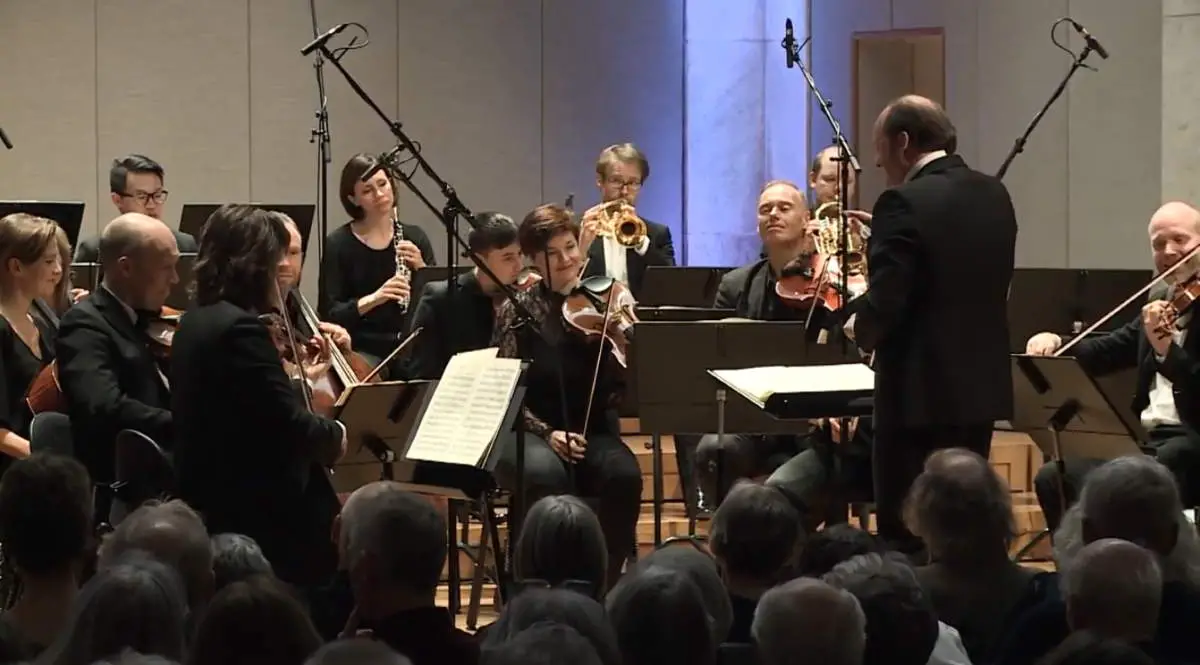Conducted by François Leleux, the Norwegian Chamber Orchestra performs Wolfgang Amadeus Mozart’s Symphony No. 28 in C major, K. 200/189k. The exact composition date of the symphony is unknown, but it is one of Mozart’s Salzburg-era symphonies (1771-1777). It was probably composed in 1773 or 1774.
Mozart’s Symphony No. 28
If the piece was composed in 1774, Symphony No. 28 followed rather than preceded the 29th and the 30th symphonies. This symphony is scored for 2 oboes, 2 horns, 2 trumpets
- Allegro
spiritoso , 3/4. The movement begins with a four-chord downward arpeggio before the fun begins in the violins. There’s a key change for the longer second subject, plus a brief closing theme in C major. After an exposition repeat, the principal theme not only dominates a short, spicy development but leads off the reprise and coda, too. - Andante in F major, 2/4. The 2nd movement opens with an aria-like, legato main theme for muted violins, but it is the third, closing subject (in sixteenth notes) that occupies a brief development section.
- Menuet – Trio, 3/4. This is a danceable minuet with oboes doubling both song-section themes for violins.
- Presto, 2/2. The last movement, even by Mozart’s standards, was “insouciant”, according to music writer Roger Dettmer. “Craftsmanship is masterly, the more astonishing when it’s remembered that this isn’t the usual rondo-finale, but sonata form. The violins‘ trilled main theme, like the whir of hummingbird wings, is the principal subject of both the development and a brief coda, wherein oboes double the trills – thrills in fact, given the challenge of Mozart’s vivacious tempo.”
Norwegian Chamber Orchestra

The Norwegian Chamber Orchestra is a virtuoso and innovative collective of musicians consisting of some of the leading Nordic string players.
As one of the leading chamber orchestras in the international concert arena, the orchestra is constantly developing its distinctive playing style and orchestral culture, and in recent years the orchestra has worked with new communication methods where performances through memorization have been central.
This has helped to strengthen the orchestra’s position as an internationally important player who renews the classical music tradition.
Pekka Kuusisto is the orchestra’s artistic director, a position he took over in August 2021 after Terje Tønnesen, who held this position since the start in 1977.
In addition, Iona Brown had a prominent role as artistic director for a long time. The orchestra has also had a number of guest conductors such as Leif Ove Andsnes, Martin Fröst, François Leleux, Steven Isserlis, Anthony Marwood, and Lorenza Borrani.
With more than 40 recordings, most of the repertoire for string orchestra has been recorded, in addition to an extensive solo repertoire with performers such as Leif Ove Andsnes, Truls Mørk, Terje Tønnesen, Lars Anders Tomter, and Tine Thing Helseth. Several of them have achieved great international recognition, and in Norway, the orchestra has received four Spellemann prizes, as well as several other awards.
The chamber orchestra has its main work in Oslo with its own concert series in the University’s Aula and at Sentralen.
In addition, the orchestra sees it as its social mission to conduct concerts throughout the country to the greatest extent possible.
A natural part of this business is playing concerts with Norwegian performers, and the list of soloists the orchestra has collaborated with is long.
The orchestra has visited concert halls across large parts of Europe, the USA, and Asia several times, and regularly invites international soloists and conductors who contribute to developing the orchestra’s artistic qualities while providing the audience with an exciting concert offer.
Sources
- Symphony No. 28 (Mozart) on Wikipedia
- Wolfgang Amadeus Mozart Symphony No. 28 in C major, K. 200 (K. 189k) on All Music
- Norwegian Chamber Orchestra’s official website
